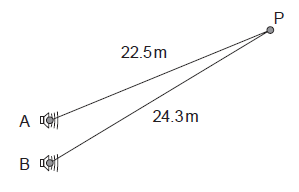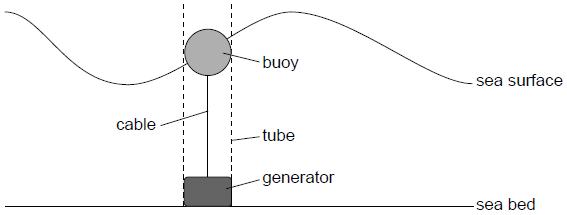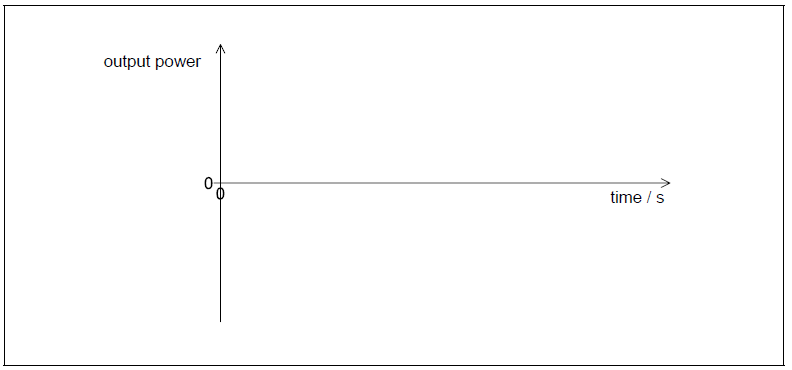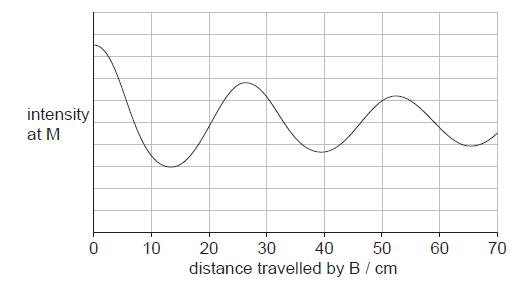
Topic 4 - Oscillations and Waves
Question 1
HLPaper 2Two loudspeakers, A and B, are driven in phase and with the same amplitude at a frequency of . Point P is located from A and from B. The speed of sound is .

In another experiment, loudspeaker A is stationary and emits sound with a frequency of . The microphone is moving directly away from the loudspeaker with a constant speed . The frequency of sound recorded by the microphone is .
Deduce that a minimum intensity of sound is heard at P.
A microphone moves along the line from P to Q. PQ is normal to the line midway between the loudspeakers.

The intensity of sound is detected by the microphone. Predict the variation of detected intensity as the microphone moves from P to Q.
When both loudspeakers are operating, the intensity of sound recorded at Q is . Loudspeaker B is now disconnected. Loudspeaker A continues to emit sound with unchanged amplitude and frequency. The intensity of sound recorded at Q changes to . Estimate
Explain why the frequency recorded by the microphone is lower than the frequency emitted by the loudspeaker.
Calculate .
Question 2
HLPaper 2A buoy, floating in a vertical tube, generates energy from the movement of water waves on the surface of the sea. When the buoy moves up, a cable turns a generator on the sea bed producing power. When the buoy moves down, the cable is wound in by a mechanism in the generator and no power is produced.

The motion of the buoy can be assumed to be simple harmonic.
Water can be used in other ways to generate energy.
Outline the conditions necessary for simple harmonic motion (SHM) to occur.
A wave of amplitude 4.3 m and wavelength 35 m, moves with a speed of 3.4 m/s. Calculate the maximum vertical speed of the buoy.
Sketch a graph to show the variation with time of the generator output power. Label the time axis with a suitable scale.

Outline, with reference to energy changes, the operation of a pumped storage hydroelectric system.
The water in a particular pumped storage hydroelectric system falls a vertical distance of 270 m to the turbines. Calculate the speed at which water arrives at the turbines. Assume that there is no energy loss in the system.
The hydroelectric system has four 250 MW generators. Determine the maximum time for which the hydroelectric system can maintain full output when a mass of kg of water passes through the turbines.
Not all the stored energy can be retrieved because of energy losses in the system. Explain two such losses.

Question 3
HLPaper 2Titan is a moon of Saturn. The Titan-Sun distance is times greater than the Earth-Sun distance.
The molar mass of nitrogen is .
Show that the intensity of the solar radiation at the location of Titan is .
Titan has an atmosphere of nitrogen. The albedo of the atmosphere is 0.22. The surface of Titan may be assumed to be a black body. Explain why the average intensity of solar radiation absorbed by the whole surface of Titan is .
Show that the equilibrium surface temperature of Titan is about .
The mass of Titan is 0.025 times the mass of the Earth and its radius is 0.404 times the radius of the Earth. The escape speed from Earth is 11.2 km/s. Show that the escape speed from Titan is 2.8 km/s.
The orbital radius of Titan around Saturn is and the period of revolution is .
Show that where is the mass of Saturn.
The orbital radius of Titan around Saturn is m and the orbital period is 15.9 days. Estimate the mass of Saturn.
Show that the mass of a nitrogen molecule is kg.
Estimate the root mean square speed of nitrogen molecules in the Titan atmosphere. Assume an atmosphere temperature of .
Discuss, by reference to the answer in (b), whether it is likely that Titan will lose its atmosphere of nitrogen.
Question 4
HLPaper 1The graph shows the variation with time for the displacement of a particle in a travelling wave.
 What are the frequency and amplitude for the oscillation of the particle?
What are the frequency and amplitude for the oscillation of the particle?
| Frequency / kHz | Amplitude | |
|---|---|---|
| A. | 20 | 2 |
| B. | 20 | 4 |
| C. | 50 | 2 |
| D. | 50 | 4 |
Question 5
SLPaper 1A ray of monochromatic light is incident on the parallel interfaces between three media. The speeds of light in the media are , and .
 What is correct about the speeds of light in the media?
What is correct about the speeds of light in the media?
Question 6
HLPaper 1A particle undergoes simple harmonic motion. Which quantities of the motion can be simultaneously zero?
Question 7
SLPaper 1Two sound waves from a point source on the ground travel through the ground to a detector. The speed of one wave is , the speed of the other wave is . The waves arrive at the detector 15 s apart.
What is the distance from the point source to the detector?
Question 8
SLPaper 1What changes occur to the frequency and wavelength of monochromatic light when it travels from glass to air?
| Frequency | Wavelength | |
|---|---|---|
| A. | stays the same | stays the same |
| B. | stays the same | increases |
| C. | increases | stays the same |
| D. | decreases | increases |
Question 9
HLPaper 2Two loudspeakers A and B are initially equidistant from a microphone M. The frequency and intensity emitted by A and B are the same. A and B emit sound in phase. A is fixed in position.

B is moved slowly away from M along the line MP. The graph shows the variation with distance travelled by B of the received intensity at M.

Explain why the received intensity varies between maximum and minimum values.
State and explain the wavelength of the sound measured at M.
B is placed at the first minimum. The frequency is then changed until the received intensity is again at a maximum. Show that the lowest frequency at which the intensity maximum can occur is about 3 kHz. Speed of sound = 340 m s-1
Loudspeaker A is switched off. Loudspeaker B moves away from M at a speed of 1.5 m s-1while emitting a frequency of 3.0 kHz.
Determine the difference between the frequency detected at M and that emitted by B.
Question 10
HLPaper 1A point source of light of amplitude gives rise to a particular light intensity when viewed at a distance from the source. When the amplitude is increased and the viewing distance is doubled, the light intensity is doubled. What is the new amplitude of the source?
